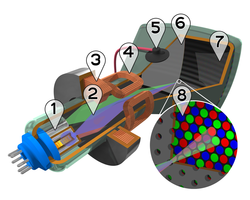Braun cathode ray tube
Autor/Urheber:
Eugen Nesper
Shortlink:
Quelle:
Größe:
1084 x 216 Pixel (48374 Bytes)
Beschreibung:
Drawing of the first cathode ray tube invented by German scientist Ferdinand Braun in 1897. It was a cold cathode tube, developed from the Crookes tube and so did not have a heated filament to produce electrons. Instead it produced electrons by ionization of residual gas in the tube with a high voltage. The tube contains a platinum cathode electrode (right end), an anode electrode consisting of an open tube in the neck to focus the electrons into a narrow beam (center right), a pair of flat deflection plates (center left), and a paper screen (left) painted on the inner side with a fluorescent chemical like zinc sulfide or calcium tungstate. When a high voltage is applied between the cathode and anode, it creates positive ions which are attracted to the negative cathode. When they strike the cathode they knock out electrons (cathode rays) which are accelerated down the tube to the left, through the anode tube, between the deflection plates, and strike the fluorescent screen at the left end, producing a glowing spot. If a second voltage is applied between the deflection plates the electron beam will be repelled by the positive plate and attracted toward the negative plate, so the spot on the end screen will move toward the positive plate.
Lizenz:
Public domain
Credit:
Retrieved on 11 October 2013 from Eugen Nesper 1921 Handbuch der Drahtlosen Telegraphie und Telephonie, Julius Springer, Berlin, p. 78, fig. 46 on Google Books
Relevante Bilder
Relevante Artikel
KathodenstrahlröhreDie Kathodenstrahlröhre ist eine Elektronenröhre, die einen gebündelten Elektronenstrahl erzeugt. Dieser kann mittels magnetischer oder elektrischer Felder abgelenkt bzw. moduliert werden, so dass ein sichtbares Bild erzeugt wird, wenn der Elektronenstrahl beim Auftreffen auf eine an der Innenseite der Röhre angebrachte Leuchtstoff-Schicht trifft. Für andere Zwecke wird der erzeugte Elektronenstrahl nicht zur direkten Anzeige verwendet, zum Beispiel im Elektronenmikroskop, Betatron oder der Röntgenröhre. .. weiterlesen











